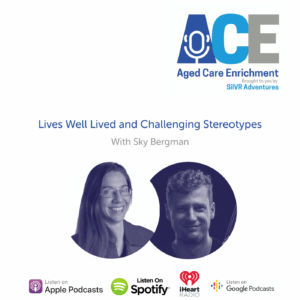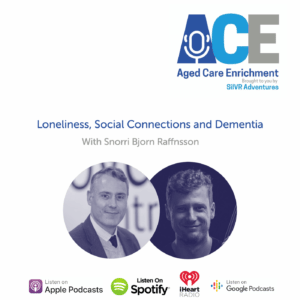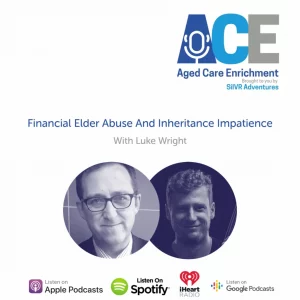Dr. Jenny Waycott is a senior lecturer at Melbourne University who’s work is focused on human-computer interactions and how people are using technology in all aspects of their lives.
Her most recent research has examined the ways in which emerging technologies can be used to enrich the lives of older adults. Particularly in residential aged care, and she’s done a lot of work with the staff of these facilities to understand how the technologies are being used and the possible benefits and ethical concerns of their implementation.
In this conversation Jenny talks about some ways that technology like virtual reality, social robots and communication technologies can be used to enhance the quality of life of older adults in residential care.
Transcript
Ash de Neef: Thank you so much for joining us today, Jenny, on the podcast.
Dr. Jenny Waycott: You’re welcome. Thank you for having me.
Ash de Neef: Can we start with a bit about yourself and your research?
Dr. Jenny Waycott: So I work in the field of research called human computer interaction. So it’s an interesting interdisciplinary area of research that brings together technology, looking at how we can design new technologies. But also a focus on people and how people benefit from new technologies, how people use technologies, what the experience is like when we’re using new technologies, how we can improve that experience.
So I work in the school of computing and information systems at the University of Melbourne, but I don’t have a background in computer science. I come from originally a background in psychology. So I’m very much interested in the human part of the human computer interaction relationship and in the last eight years or so, I’ve been focusing on older people and designing for older people, designing for aged care settings. Looking at how technologies are being used in interesting ways in aged care and to support older people who might be feeling socially isolated to help them feel socially connected.
So, yeah, it’s an area where I think there’s a lot of potential for new technology to provide great social benefit, but it’s also an area where there are a lot of challenges and there’s a lot of, there’s a risk of if things don’t work according to plan, you know, actually creating problems for, for the people using the technology.
And so I’m quite interested in how we can make sure that we design and deploy new technologies in ways that are not only beneficial for the older people and for aged care, but also that don’t create burdens or ethical challenges in that setting.
Ash de Neef: Great, It sounds like there would be a lot of work in, in design, as you said. And re-imagining the way technologies are used. Before we touch on that sort of area can we talk about the actual research you’re doing or you’re going into aged facilities? You’re working with developers. What does it look like your day-to-day work?
Dr. Jenny Waycott: Yeah. So I’m currently working on a project that, it’s sort of a program of research, I guess. And it’s looking at emerging technologies for enrichment in later life. I’m focusing in particularly on residential care at the moment, but I’m also looking at other settings – so older people living independently.
What I have been doing in the last couple of years is focusing on, looking at the technologies that are currently in use and how they’re being used, how they’re being incorporated into care activities. How they are being used to enrich the lives of people living in aged care, because as we know, aged care can be a place where people may feel disconnected from the world. Especially at the moment we’ve, we’ve seen that sense of disconnection really vividly this year.
But it can also be a place where there’s not quite enough to keep people engaged and entertained. And so I’m looking in particular at how technologies are being used for what I call enrichment, which is the name of this podcast.
So not, not necessarily for health and care, but for helping people to stay engaged in the world and to stay engaged in meaningful activities and to feel connected to other people and feel connected more broadly to the world around them. So that work has involved predominantly interviewing aged care providers and technology developers about how they’ve been using the technologies.
And why they’ve gone into aged care in the case of technology developers. In the case of aged care staff, what are the challenges that they’re facing? What are the opportunities they see for a range of new technologies and how they’re incorporating those into their care activities?
That’s one arm of the research, there’s also a number of other projects that my students are doing. Some of which involve more design activities or focusing on specific technologies, such as virtual reality or social robots. A lot of that work at the moment, we’re not able to, we haven’t been able to proceed with it this year because of the limitations in getting access to aged care homes.
And, you know, obviously aged care has other priorities at the moment. So taking part in research is not central to their issues while they’re dealing with this COVID-19 pandemic, which is understandable. But at the same time we can see from what’s happened this year, how important it is to make sure that aged care homes are well set up to enable residents to stay connected and to use technology effectively.
So it’s, it’s really important that they’re well supported in using technology in positive ways.
Ash de Neef: Cool. And you said you’re spending a lot of time interviewing the staff at aged care facilities. What are you finding with their reaction to technology in the setup?
Dr. Jenny Waycott: Yeah, so I’m finding that the people that I’ve been talking to and I acknowledged that this is a biased sample. So I’ve been talking to people who are actively using the technology in aged care.
But they – what I’m finding is that there, they often are incorporating technology-based activities as part of a person-centered care approach to care-giving. And so they’re identifying particular needs that people have so particular needs for connection that people have.
And seeing where there’s a role for technology to play in helping facilitate those connections. So they might be kind of specific examples like somebody wants to be connected to their family, to remotely attend a family event. Through to helping people to reminisce about life experiences by using something like virtual reality and visiting places that people previously visited or previously traveled to or grow up in.
And using that as a way of exploring life experiences.
Ash de Neef: Great. And does it seem like the staff that you’ve spoken to are in favour of the use of this use of technology?
Dr. Jenny Waycott: Yes. The staff that I’ve, I’ve spoken to her in favour of using it when it addresses a need. So it’s not necessarily a blanket let’s use technology because technology is there kind of approach, but much more a case of this is something that we can see the benefit that that technology can provide.
Whether that’s virtual reality for traveling to another place or whether that’s something as simple as being connected via Skype. They’re generally open to the opportunities that these technologies provide, but only in the sense that they respond to a particular need that the people they care for have.
Ash de Neef: Right. So it needs to be somewhat targeted with the use of the technology.
Dr. Jenny Waycott: Yeah.
Ash de Neef: Great. Now you’ve mentioned that some of your research has been involved in the ethical concerns of using technology in residential facilities. What concerns are there?
Dr. Jenny Waycott: So I view kind of the ethical concerns fairly broadly, and I look at what are some of the negative experiences that people can have and how can we avoid those negative experiences?
So the ethical issues, I guess I’ve encountered with technology like virtual reality for example, is that it can be quite frightening for people. And it can be difficult for the caregivers to monitor people’s experiences and to be able to assess how somebody is responding. And so you can inadvertently put somebody in a situation where they experience a fright because they are fully immersed in a virtual world and it’s a 3d world.
And there might be the sense that things are happening behind you, or that you’re standing at the edge of a cliff. Or that you’re one of the virtual reality experiences that seems to be quite popular because it’s quite a calming experiences to do an underwater activity, but it may be that somebody may have negative associations with water.
And how do you make sure that you’ve identified the right kind of activity to suit that particular person? How do you know… how do you make sure, you know, enough detail about somebody’s life to ensure you’re not kind of revisiting trauma revisiting a traumatic experience?
And so I think in aged care, it can be particularly challenging to make sure that technology is used in a way that provides positive experiences, because there’s a lot of uncertainty around what sort of things are going to trigger negative memories and negative experiences.
And this can be as simple – I mean, I’ve mentioned virtual reality and being immersed in a virtual world, but it can be as simple as knowing what songs are going to bring people joy or that people might associate with experiences that they either don’t want to revisit or that they feel grief about not being able to go back to.
So there’s, there’s also when technology is used for that to support reminiscence, there is that issue of exposing people to the grief of revisiting experiences that they’d shared with people who are no longer with them, or revisiting experiences that they can no longer enjoy.
Or as I said, revisiting traumatic experiences without the caregiver, knowing that that’s going to happen. So that’s, I mean, that’s, that’s one of the issues that I think makes technology, particularly, and any activity actually particularly challenging in aged care settings.
Ash de Neef: Absolutely. Do you think that a key element in addressing this concern is having a very thorough person centered approach and knowing the clients very well?
Dr. Jenny Waycott: Yes. That is definitely a strategy. And I guess that raises one of the key challenges for using technology well in aged care. And that is that it does require time. Sometimes technology is seen as an efficient way of supporting [or] augmenting care.
But actually to do it well and to ensure it does have that enrichment, that we’re aiming for it does require that person centered approach to care. Which does require knowledge about the person you’re caring for, which then requires the investment of time to, to get to know the person. And probably some of the more positive samples, the really lovely stories that have come out through my research have been shared by people who volunteer in aged care, and so they’re able to spend time getting to know a person.
And then as they get to know the person, that’s when they start introducing some of the activities using technology to help revisit life experiences. But you know, that kind of one-on-one support is not usually available in residential care settings.
Ash de Neef: Yeah. What I really like about that, Jenny is that it really dispels the myth that you can just bring in new technology and hope that it’s going to fix anything. Technology has never been a solution. It’s been a tool which when used correctly can be of assistance, but the connection with people is always going to be paramount.
Dr. Jenny Waycott: Absolutely. Yeah. That’s, that’s exactly right.
Ash de Neef: So you mentioned VR and… what other technologies are you seeing being used effectively at the moment?
Dr. Jenny Waycott: I guess another technology that gets talked about a lot is the use of robots in aged care. One area where robots are potentially effective is when they’re pet robots.
So when you’ve got things like Paro the seal, it’s been around for a very long time, but then we’ve got some other cheaper pet like robotic toys. They’re very simple. They respond to touch and they just provide a sense of comfort for people. They seem to be very popular with some people.
They seem to be a very effective way of giving people the sense of companionship that a pet might give them when you’re not in a situation where you can have a pet or where the animals are not allowed to visit. I mean, most aged care homes do have animal visiting programs, but the robots can be a little bit more of a permanent presence.
Ash de Neef: So this is for example, a robotic dog that would sit on a lap or what kind of things they do.
Dr. Jenny Waycott: Yeah exactly that a robotic dog that would, you’d pet it and it would move its head a little bit and make some small noises in response and just, it can be, it can respond in a sort of very simple way, but just to show that it’s an animated. Somewhere between a soft toy and a more sophisticated robot.
So it’s just makes small responses to being petted and talked to, and just provides that comfort of having an object to love in a way.
Ash de Neef: In the situations that we’ve just been talking about. These are examples of technology being used with, or for aged care reasons or for older adults, how are older adults using technology themselves these days?
Dr. Jenny Waycott: Yeah so there’s some great examples. I mean, and a lot of older people are really active online and certainly I don’t buy into the stereotype that once you reach a certain age, you’re unable to use technology.
But there’s some really, really great examples of older people who’ve who are embracing online platforms like YouTube to share content and to really connect with younger generations.
One of my favorite examples is it’s a lady called Shirley Curry. She’s in her eighties and she’s got the nickname of gaming grandma. And she plays online games and records, you know, her gameplay and shares that over YouTube. And she’s got this great YouTube following all these people who, who follow this gaming grandma and her gaming adventures.
And I just love that example because it is, it just defies the stereotype and it also because she’s interested in this activity. There’s no reason why older people can’t be interested in gaming. You know, it doesn’t have an age limit. So she, she enjoys it. She’s interested in it. And it gives her that connection to this global inter-generational audience.
And there are other examples, like. Older people who have a YouTube tutorials on cooking. So, you know, you might have your Italian grandma cooking tutorials on YouTube. And in fact, one of the first YouTube stars was a man in his seventies at the time. And he was, he shared videos of his, just talking about his life, talking about his adventures using technology. Talking about some of the past adventures he’d had and really through that regular sharing of these videos and the comments from the audience, he was able to develop this really, really interesting connection with this global audience.
He’s no longer with us, unfortunately, but it’s a really interesting example of technology being used to help somebody feel connected to the world by sharing information about themselves.
So they’re not just feeling connected to the world by say watching news on TV, but by actively engaging in using the technology that’s available.
Ash de Neef: Now you mentioned that in the design space, there’s probably some room to tailor technologies or develop technologies that are more suited to older adults.
What have you found in that area?
Dr. Jenny Waycott: What I’ve found I guess, is that older people are quite keen to be involved in technology design. So if we want to kind of tailor technology for older people, We can involve them in the design process. And again, there’s some great examples of older people being involved in design.
So there’s an organisation in the United States called Tech Enhanced Life. And they have regular sessions with a group of older people who they call the longevity explorers, and they come along to these workshops and basically explore prototypes or technology designs that they’re evaluating for some of the companies in Silicon Valle. They critique the technology and they get involved in thinking about how technology can best be designed to support them.
And then there are people who are aged in their seventies, eighties, nineties. So we’re not talking about necessarily the new retirees, but people who are further along in, in the old age journey. So that’s a really great example.
And some of the research that I’ve been involved in, we did something similar where we worked on a project that involved developing a bespoke social virtual reality application that we trialed with a group of older people.
And we worked closely with the group of older people who came into our lab on a monthly basis to explore different virtual reality applications. To explore what those applications could do for them, what they would want out of a virtual reality experience, where they would enter the virtual environment and interact with other people inside the virtual environment.
And so we were able to create something that was very much tailored to their interests, and this work was led by a colleague of mine, Stephen Baker. And in that particular case, we developed an environment that was made to look like an old classroom, a feeling neutral school classroom. And so it was an opportunity to reminisce about what life was like in school days.
So, yeah, I think. If we’re going to tailor technologies for older people, the best way to do that is to involve older people in the design process. And, you know, they have a wealth of rich life experiences to draw from.
They’ve seen new technologies come and go. They can critique technology from a perspective where they’ve got quite a lot of expertise on what they know works and what they know doesn’t work.
Ash de Neef: Yeah, fantastic. That’s echoing a conversation we had a few weeks back with Juliane Parkinson.
Who’s the head of an organisation called the Global Center for Modern Ageing, which does that as well. They do a lot of research with older adults to design technologies and services.
In the prototype that you developed in your research with Stephen Baker, was this an avatar based situation?
[Where] people would have like a personalised avatar. They’d sit in the classroom and look around at each other?
Dr. Jenny Waycott: Yes exactly. And so we had a PhD student, Romina Carrasco who designed the avatars with our participants. And so her research focused particularly on the avatar creation and then how being represented via an avatar made people feel. And what were some of the opportunities there as well as some of the challenges?
So, yeah, everyone was represented as an avatar and they came into this classroom environment to interact as avatars.
It was really interesting concept. It’s something a little bit more than what you can get through video conferencing because you’re actually in a shared space.
Ash de Neef: And did you find that the participants were expressing themselves through the avatar creation?
Dr. Jenny Waycott: Yeah. Yeah, definitely. So Romina worked with the participants to create a photo realistic avatar. So an avatar that looked like them and a cartoon avatar. So a more adventurous creative avatar. And so the cartoon advertise were a really interesting way to explore identity and to explore how you might want to be represented.
In reality, a lot of people chose to use the photo realistic avatars now are actually interacting in the environment. But the process of creating a cartoon avatar was a really interesting creative process. And again, it’s another example of using technology creatively and actively to express yourself.
Ash de Neef: Absolutely. One of the common tropes in, in gaming these days seems to be the ability to, to fill a role that you would not normally fill, and to explore the depths of the character that you might inhabit. And it’s a really interesting idea that within technology for older adults, this could be a new avenue of exploration as well.
Dr. Jenny Waycott: Yeah, absolutely. Some interesting examples where things like one of the male participants created a cartoon avatar that had him really muscular because he’d always considered himself to be quite thin. And I suppose there’s an element of coming to terms with some of the frailty that you might experience as you’re getting older. And just being able to embody an avatar that represented the exact opposite to that frailty was quite interesting.
Ash de Neef: Absolutely. I could say there might be a way in recognising that this particular participant wanted to be seen in a certain way. Perhaps there are situations in virtual reality, you can build that really capitalise on what older adults want to feel and what they feel their shortcomings might be in how to address those.
Dr. Jenny Waycott: Yes.
Ash de Neef: Now we kind of touched on the idea of age-ism being a factor in people’s perceptions of older adults with technology. Do you think it’s fair to say that in 20 years older adults will have more familiarity with technology or is it going to change in a way that we won’t be able to keep up with?
Dr. Jenny Waycott: I think probably the latter. Look I again don’t want to suggest that older people are always going to struggle to be on top of technology, but the fact is things change a lot. And what we learn in our younger years is not necessarily going to be around as we get older. So, I mean, I noticed that myself, just the difference between me and my teenagers, in terms of what we’re familiar with is, you know, there are differences. But that doesn’t mean that people can’t stay active and involved and using different technologies. It just means that this idea of there’s often this argument that as soon as people who are currently using social media reach a certain age, then all of those issues around digital literacy and no longer are going to exist.
But I think, I think those issues will always be there as long as the world keeps changing and not being able to use technology is not a universal constraint for people. But there will always be people who feel a bit left behind because they feel like the world has moved on faster than they’ve been able to keep up with.
I think we always need to be mindful of making sure that aspects of society are accessible for all.
Ash de Neef: Mmm. And I think the way that you’ve been researching as well, the research you’ve been part of – actively seeking the involvement of older adults. It sounds like that moving forward, that’s going to be a key factor in the adoption of new technologies by older adults is actively working them in to use them.
Dr. Jenny Waycott: Yes, definitely. Depending on how the technology is being used, what setting it’s being used in, what the context is, it’s important to involve older people. But also others who are included in that as users.
So in residential care, for example, the staff members play a really crucial role. So it’s important to involve them and to understand their perspectives on some of the constraints that affect their working lives and making sure that the technology, if it’s going to work well, that fits into those environments. So, yeah, it’s about involving a whole network of people in the process.
Ash de Neef: Absolutely. I guess the care providers are the facilitators of the technology in a lot of situations.
Dr. Jenny Waycott: Yes definitely.
Ash de Neef: We’re almost running out of time, but I just wanted to ask you. We’ve spoken about technology being used as a tool to address specific problems and I know you mentioned isolation – are there other key areas you think technology can be really instrumental in helping address?
Dr. Jenny Waycott: Yeah. So my work has focused mostly on addressing isolation or facilitating a sense of connected-ness to the world. And so even people who are not necessarily socially isolated can still, they might have personal relationships with others, but they may lack that broader connection, for example, or vice versa.
There’s a whole area of work on the use of technology for health care. I’m not looking so much at that b because I’ve been so focused on kind of just the social aspects. But I guess, and I’ve touched on this a fair bit, there’s also that, just that sense of being able to provide people with an opportunity to engage in meaningful activities and do something that’s fun.
So, you know it’s not always about connecting with other people. Sometimes it’s just about having to do things that you enjoy and not everybody enjoys the kinds of activities that are on offer in aged care settings. Like for example your games of bingo.
So having those kinds of individual fun based activities can be really valuable for some people.
So it’s, it’s about, just making sure people have lots of different things to do. And that’s where social technologies provide an advantage and games and there are motion-based games that could help people to kind of do something fun. And then at the same time stay active.
So yeah, those are some interesting areas.
Ash de Neef: I like the idea of technology as a part of a, a social care, not just a health care that that’s often implicit in these residential facilities. Jenny, we’re pretty much out of time. Is there anything you’d like to touch on today or anything you think people should know about your research before we go?
Dr. Jenny Waycott: So some of the work that I’ve been doing precedes 2020, and I’m very interested to learn about how aged care organisations have innovated in response to the challenges that they have faced this year. Especially in terms of keeping residents connected in residential care, but also for care services that operate at a community level.
So how have organisations enabled their clients who live in the community to stay connected and to stay involved in some of the activities that they’ve run. So there are some examples of libraries, for example, that have telephoned all of their older members.
And so I am currently embarking on a followup study to look at how aged care organisations, both in residential care and in community-based care have innovated in response to COVID-19 in order to help older people stay connected.
Ash de Neef: And are you optimistic that coming through the pandemic, there’ll be lots of findings of how people can, how technology can be used more effectively?
Dr. Jenny Waycott: Yeah, I think it’s a really interesting opportunity to suddenly for people who may have thought technology was too hard to have suddenly embraced it. And there’ll be a lot of lessons to learn from that. Including, not just what the opportunities are, but also what the challenges are and what we need to do to make sure that people are well supported to be able to do this effectively going forward.
Ash de Neef: Fantastic. Jenny, thank you so much for your time today.
Dr. Jenny Waycott: Thank you very much. Thanks for having me.




